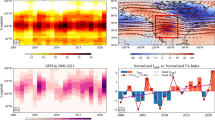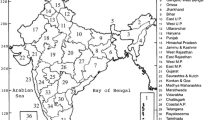Abstract
Snowfall is considered a natural disaster in southern Brazil, where a little infrastructure exists up to prevent against the damage it induces, making snowfall forecast a matter of great interest in this region. The present article aims to describe the mean behavior of low, mid, and high atmospheric levels during snowfall occurrences in southern Brazil. Sea-level pressure (SLP), 1000–500 hPa atmospheric thickness, geopotential height at 500 hPa, and wind speed at 200 hPa have been analyzed. One hundred and ninety-six snowfall records from the conventional surface meteorological stations have been selected for the period from 1979 to 2015. The surface synoptic pattern associated with snowfall occurrences has been obtained from ERA-Interim reanalysis data with horizontal spatial resolution of \(0.75^\circ \times 0.75^\circ\) and temporal resolution of 12 h. SLP fields show a high-pressure transient system displacement from the Pacific Ocean to northeastern Argentina. In addition, it is possible to relate snowfall with displacement of a low-pressure system on the coast of southern Brazil. Thickness fields indicate shallow cold air mass intrusions one day before snowfall. Such a cold air continues moving towards low latitudes during consecutive snowfall days and it may be responsible for frost events in climatologically warm regions. Finally, mid and high atmospheric levels show an eastward propagating wave amplified by the Andes.

















Similar content being viewed by others
Notes
Brazilian Yearly Report of Natural Disaster, in a free translation.
References
Barrett BS, Henderson GR, Werling JS (2015) The influence of the MJO on the intraseasonal variability of Northern Hemisphere spring snow depth. J Clim 28(18):7250–7262. https://doi.org/10.1175/JCLI-D-15-0092.1
Bluestein H (1992) Synoptic-dynamic meteorology in midlatitudes. Oxford University Press, Oxford
Cavalcanti IF, Müller GV, Andrade KM, Long MEF (2013) Cold air intrusions over southeastern south america-gfdl model behavior regarding climate simulations in the 20th century and future projections. Glob Planet Change 111:31–42
Cenad (2014) Anuário brasileiro de desastres naturais: 2013. http://www.mi.gov.br/defesacivil/publicacoes. Accessed 28 Feb 2017
Civil Defense of Santa Catarina (2013). http://www.defesacivil.sc.gov.br/4246-frio-em-santa-catarina-requer-atencao-. Accessed 20 Feb 2017
Dee D, Uppala S, Simmons A, Berrisford P, Poli P, Kobayashi S, Andrae U, Balmaseda M, Balsamo G, Bauer P et al (2011) The era-interim reanalysis: configuration and performance of the data assimilation system. Q J R Meteorol Soc 137(656):553–597. https://doi.org/10.1002/qj.828
Dolif Neto G, Market PS, Becker AE, Pettegrew B, Melick C, Schultz C, Buckley PI, Clark JV, Lupo AR, Holle R, Demetriades N, Barbieri CE (2009) A comparison of two cases of low-latitude thundersnow. Atmósfera 22(3):315–330
Dolif Neto G, Market PS, Pezza AB, Morales Rodriguez CA, Calvetti L, Dias S, Leite P, Escobar GCJ (2016) Thundersnow in Brazil: a case study of 22 July 2013. Atmos Sci Lett 17(1):26–32
Fortune MA, Kousky VE (1983) Two severe freezes in Brazil: precursors and synoptic evolution. Mon Weather Rev 111(1):181–196
Fuentes MV (2009) Dinâmica e padrões da precipitação de neve no sul do Brasil. Doutorado em geofísica, Universidade Federal do Rio Grande do Sul, Porto Alegre
Garreaud R (2000) Cold air incursions over subtropical south america: mean structure and dynamics. Mon Weather Rev 128(7):2544–2559. https://doi.org/10.1175/1520-0493(2000)128<2544:CAIOSS>2.0.CO;2
Grimm AM (2009) Frentes frias sobre o sul do Brasil. In: Cavalcanti IFA, Ao F, Dias MA, Justi MGA, Ferreira NJ (eds) Tempo e clima no Brasil, chapter 17. Oficina de Textos, São Paulo, pp 259–275 (in portuguese)
Heim R Jr, Dewey KF (1984) Circulation patterns and temperature fields associated with extensive snow cover on the North American continent. Phys Geogr 5(1):66–85. https://doi.org/10.1080/02723646.1984.10642244
Heppner PO (1992) Snow versus rain: looking beyond the “magic” numbers. Weather Forecast 7(4):683–691. https://doi.org/10.1175/1520-0434(1992)007<0683:SVRLBT>2.0.CO;2
Johnston EC (1995) Updated satellite technique to forecast heavy snow. Weather Forecast 10(2):219–228. https://doi.org/10.1175/1520-0434(1995)010<0219:USTTFH>2.0.CO;2
Marengo J, Ambrizzi T, Kiladis G, Liebmann B (2002) Upper-air wave trains over the pacific ocean and wintertime cold surges in tropical-subtropical south america leading to freezes in southern and southeastern Brazil. Theor Appl Climatol 73(3):223–242
Marengo J, Cornejo A, Satyamurty P, Nobre C, Sea W (1997a) Cold surges in tropical and extratropical south america: the strong event in June 1994. Mon Weather Rev 125(11):2759–2786
Marengo JA, Nobre CA, Culf AD (1997b) Climatic impacts of “friagens” in forested and deforested areas of the amazon basin. J Appl Meteorol 36(11):1553–1566. https://doi.org/10.1175/1520-0450(1997)036<1553:CIOFIF>2.0.CO;2
Mintegui JM, Puhales FS, de Lima Nascimento E, Weber TM, Silva GG, Anabor V, Dal Piva E, de Souza Cruz G (2015) Multi-layer atmospheric analysis during snow episodes in southern Brazil. Ciência e Natura 37(2):356. https://doi.org/10.5902/2179460X17350 (in portuguese)
Müller GV, Berri GJ (2007) Atmospheric circulation associated with persistent generalized frosts in central-southern south america. Mon Weather Rev 135(4):1268–1289
Müller GV, Ferraz SET, Ambrizzi T (2009) Propagacão das ondas de rossby nos invernos de máxima freqüência de ocorrência de geadas na pampa úmida. Rev Bras Meteorol 24(1):56–62. https://doi.org/10.1590/S0102-77862009000100006 (in portuguese)
Müller GV, Gan MA, Dal Piva E (2017) Energetics of wave propagation leading to frost events in south america: extratropical latitudes. Atmos Sci Lett 18(8):342–348
Nimer E (1979) Climatologia do Brasil. Secretaria de Planejamento da Presidência da República, Fundação Instituto Brasileiro de Geografia e Estatística, Diretoria Técnica, Superintendência de Recursos Naturais e Meio Ambiente, Rio de Janeiro (in portuguese)
Peixoto JP, Oort AH (1992) Physics of climate. Springer, New York
Pezza AB, Ambrizzi T (2005) Dynamical conditions and synoptic tracks associated with different types of cold surge over tropical south america. Int J Climatol 25(2):215–241
Vera CS, Vigliarolo PK (2000) A diagnostic study of cold-air outbreaks over south america. Mon Weather Rev 128(1):3–24
Wilks D (2006) Statistical methods in the atmospheric sciences, 2nd edn. Academic Press, San Diego
Acknowledgements
The authors would like to thank Coordenação de Aperfeiçoamento de Pessoal de Nível Superior (CAPES) and Conselho Nacional de Desenvolvimento Científico e Tecnológico (CNPq - Universal 422161/2016-0) for financial assistance, \(8^\circ\) Distrito do Instituto Nacional de Meteorologia and Centro de Informações de Recursos Ambientais e Hidrológicos de Santa Catarina (Ciram) for the data provided, the contributions of anonymous reviewers, Michel Kaplan (editor), and Otávio Costa Acevedo for important contributions in this work.
Author information
Authors and Affiliations
Corresponding author
Additional information
Responsible Editor: M. Kaplan.
CNPq Universal 422161/2016-0.
Appendix A: Weather station location
Appendix A: Weather station location
Rights and permissions
About this article
Cite this article
Mintegui, J.M., Puhales, F.S., Boiaski, N.T. et al. Some mean atmospheric characteristics for snowfall occurrences in southern Brazil. Meteorol Atmos Phys 131, 389–412 (2019). https://doi.org/10.1007/s00703-018-0578-5
Received:
Accepted:
Published:
Issue Date:
DOI: https://doi.org/10.1007/s00703-018-0578-5




